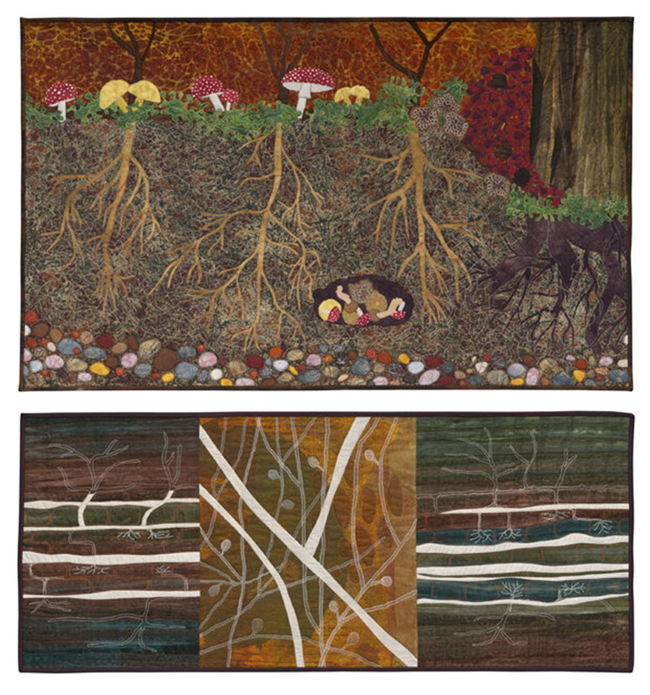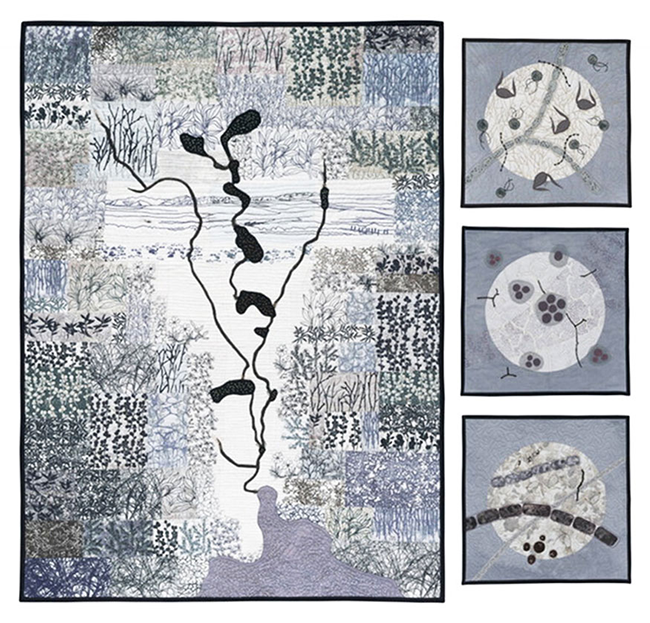Artwork Collaborations / Microbial Worlds
ITOC: Microbial Worlds | Mary Beth Leigh
Mysterious Underground Collaboration: Mysterious Underground, Mycorrhizae
Charlotte Bird, Fiber Art: Quilts | Ree Nancarrow, Fiber Art: Quilts
We worked as a team on the Microbial Worlds project. Charlotte developed Mysterious Underground as a focus quilt, and Ree responded with Mycorrhizae. One of our first study articles was Fungal roles in soil ecology: Underground Networking by Whitfield (2007; Nature 449:136-138). It told stories about symbiotic relationships between fungi and vascular plants in coastal and boreal forests. Charlotte stayed hooked on fungi throughout the ITOC: Microbial Worlds project. We took Gary Laursen’s mycology field course in Denali National Park, hosted by Alaska Geographic. The class collected and identified over 100 species. We made spore prints, dissected samples, and studied the role of fungi in mediating many energy transformation processes vital to life. That study included parasitism, symbiosis, decay, and fungi as food for insects, birds, and small mammals.
Charlotte resolved that the core of her lead piece would be images of the underground world of fungi. Dr. Laursen provided valuable clarification of relationships of fungi and vascular plants. He also confirmed that we had our mushrooms and mycorrhizae in the right habitats. While Charlotte focused on the mystery of the visible underground, Ree looked at the mysterious microscopic relationship between mycorrhizae and roots. This was a difficult piece to visualize. We can’t see underground. We see only gross remains of what is underground when edges are exposed. There are few conventions in art for depicting the underground. We worked to translate scientific text and journal drawing into images that are art, not classroom posters.

Toolik Chain of Lakes Collaboration
Ree Nancarrow,Toolik Chain of Lakes | Charlotte Bird, Microbes 1, 2 and 3
We joined Jason Dobkowski collecting specimens during our Toolik Lake field trip. Jason helped Ree find the article Biogeography of Bacterioplankton in Lakes and Streams of an Arctic Tundra Catchment by Byron C. Crump, et al. (2007; Ecology, 88:1365-1378), which guided this piece. Jason answered Ree’s questions to ensure the piece would be as scientifically accurate as possible.
For Ree, studying the microbial world changed how she looks at a landscape: “Instead of thinking of the Arctic habitat as just vascular plants, I also think of the associated invisible microbial world. Much of area to the south of the field camp drains into a single stream and one small lake, while another part drains through a series of many small lakes. The study area interested me visually, but I was also curious about how the drainage characteristics change the microscopic inhabitants.”
We watched the scientists who study different bacterioplankton communities that thrive in separate parts of the beaded stream. In Toolik Chain, the communities show subtly as differently colored French knots. Toolik Lake, the catchment basin, has its own unique community, depicted with French knots of yet another color.
Charlotte used images of microbes–five distinct groups–that we collected in water column samples. The scientists found that many of the microbial DNA profiles are not from known organisms.

